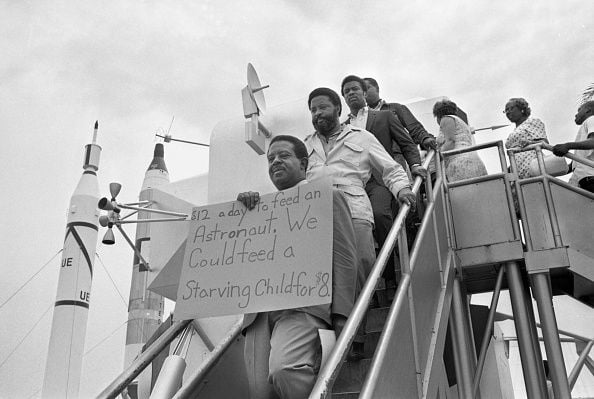The Challenge Before Us: A Historical Reflection on 1969 and 2020
On the same day that a commercially-built spacecraft docked with the ISS for the first time, cities across this nation experienced widespread protests sparked by profound racial disparities. The confluence of events drew comparisons to 1968 and 1969, when successful flights to the Moon occurred in the midst of a similarly fraught moment. Curator Margaret Weitekamp reflects.
:focal(297x199:298x200)/https://tf-cmsv2-smithsonianmag-media.s3.amazonaws.com/blogging/featured/GettyImages-695984462.jpg)
The successful docking of a commercially-built and -operated space capsule with the International Space Station (ISS) marked a culmination of NASA’s Commercial Crew Development (CCDev) program, which originated in 2010 under the Obama administration. On the same day, cities across this nation experienced widespread protests sparked by profound racial disparities. The confluence of events drew comparisons to 1968 and 1969, when successful flights to the Moon occurred in the midst of a similarly fraught moment.
Smithsonian Secretary Lonnie Bunch has challenged our storied scholarly institution to offer historical context in challenging times. As quoted in the Washington Post, he declared, “I want people to see that we are as much about today and tomorrow as we are about yesterday.” His statement released on May 31, 2020, expressed the desire that “this moment becomes the impetus for our nation to address racism and social inequities in earnest.”
Spaceflight history is inextricably embedded in that context. In 1968, the crew of Apollo 8 circled around the Moon at Christmastime, even as deaths from the Vietnam War and confrontations on campuses and cities also led the news. The day before the launch of Apollo 11, Rev. Ralph Abernathy led a protest to the gates of the Kennedy Space Center. Still reeling from the assassination of Rev. Dr. Martin Luther King Jr., Abernathy led the Poor People’s Campaign of the Southern Christian Leadership Conference (SCLC) to NASA’s doorstep to draw attention to economic and racial inequality, singing “We Shall Overcome” as they marched. Abernathy chose to stage this phase of the SCLC’s ongoing protest campaign at the site of the lunar launch because it highlighted how much could be done with a dedicated national effort.

The recent protests have roots in that same Civil Rights Movement, a decades-long history of peaceful protests interspersed with surges of frustration. In recent years, the Black Lives Matter movement began in 2013 after George Zimmerman was acquitted of killing Trayvon Martin. In 2016, NFL quarterback Colin Kaepernick began his quiet but public protests, kneeling during the national anthem before games to draw attention to racial injustice and police brutality. Athletes, politicians, celebrities, and everyday people have weighed in after each subsequent death. Just weeks ago, runners across the country tagged their social media posts to draw attention to the still unresolved case of Ahmaud Arbery, an African American man killed while running in his own neighborhood. Having racial and economic injustice as front-page news at the same moment as the SpaceX/NASA launch offers a striking historical parallel.
Watching the media coverage toggle between the elegant, high-tech cockpit of the Crew Dragon capsule Endeavour and the chaotic footage emerging from cities across the nation, it might seem that these events are not intertwined. They are. Once again, we face the same questions that Reverend Abernathy asked in 1969.
One of the strategies in this moment is to amplify and elevate the voices of people of color. In the break between the attempted launch on Wednesday and Saturday’s ultimate success, former NASA astronaut Leland Melvin posted an impassioned video on Facebook. He reflected that when he saw George Floyd being pinned by the knee of a white Minneapolis police officer, he thought, “I could have been him.” In his call for action, he reminded his audience, “It’s going to be the good people that do nothing now that start doing something to stamp this hatred, evil, and racism out.” Good people must speak out.
National efforts to achieve lofty goals require the best talents of all people. Our determination to get more young people of different races and backgrounds engaged with STEM education will not be successful unless we also come to terms with the long history of race in America. Only then will we successfully achieve the remarkable goals we have for the next generation in aerospace (and other fields). We all must do our part to address the historic divisions that hold us back.
As we each do our part to dismantle racism and foster constructive discussions about racism and its corrosive impact, you may find some of these resources from the Smithsonian helpful: "Talking About Race" web portal and "Being Antiracist" webpage from the Smithsonian’s National Museum of African American History and Culture.
Margaret A. Weitekamp is the chair of the Department of Space History and the curator of the Social and Cultural History of Spaceflight collection.
